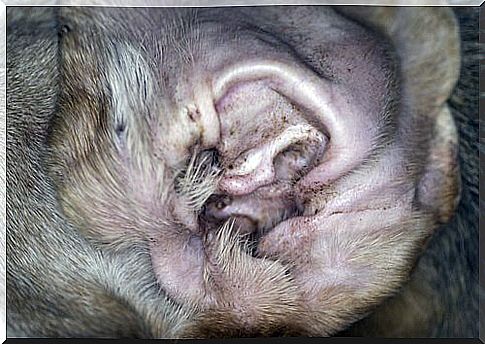Dust Mites On Dogs’ Ears: How To Treat Them

If your pet scratches its ears a lot or moves its head sideways continuously, it may have an ear problem. After all, mites in dogs’ ears are more common than you think. However, not all owners are able to recognize them. So, in this article, we’re going to talk about dog ear mites and how to get rid of them.
How do mites appear in dogs’ ears?
Mites are microscopic parasites, responsible for infections in different areas of the animal’s body.
In particular, these infections can occur in the ears. First, the two species of mites that affect dogs are Demodex canis and Otodectes cynotis .
In addition, they are responsible for demodectic and otodectic mange, known as black mange and ear mange, respectively.
All dogs, regardless of age or breed, are vulnerable to mite contagion and suffer the consequences. Even the mother herself can transmit these parasites to her offspring.
When this happens – or in any situation where two dogs are together – the mites lay eggs inside the dog’s ear.
Then, four days later, the larvae are born, which feed on the ear canal wax. Shortly thereafter, the mating phase of the nymphs begins again.

In this sense, the main problem with mites is that they reproduce very quickly. For example, a colony can double its population in just one week.
Also, mites don’t need a lot of time to cause infections or foul odors.
What are the symptoms of mites in dogs’ ears?
In addition to seeing these white spots or spots, the presence of mites in dogs’ ears manifests itself in other ways as well. Therefore, it is worth observing and identifying the following symptoms to apply the proper treatment:
- intense itching
- Shakes and sudden movements of the head
- Crusted or reddish ears
- continuous scratches
- Bad smell
- Dark brown or yellow secretion
- Bleeding due to rupture of blood vessels
- Discomfort or restlessness in general
- Inner ear with dark or white spots
How are mites removed?
For starters, it is essential to prevent the appearance of these parasites in our pets. Therefore, we recommend that you clean the animals’ ears periodically.
To do this, use an alcohol-soaked cotton ball. Also, if you bathe at home, use a special shampoo against mites.
Additionally, it is advisable to clean blankets, pillows, kennels, toys and accessories. Above all, it is necessary to strengthen the animal’s immunity through quality food.
In this way, it is possible to avoid mites that proliferate quickly. However, it is always worth remembering that you should take your pet to the vet for exams, at least once or twice a year. Finally, one last reminder, don’t forget to stick to the vaccination schedule!

In turn, to diagnose mites in pets, veterinarians make a direct observation of the animal’s ears.
Then they collect a wax sample with a cotton swab. The material is then analyzed under a microscope to determine if there are “moving white spots” that indicate the presence of parasites.
Medicines and home remedies against mites
The veterinarian can recommend a specific remedy to eliminate mites, which can be purchased at the clinic or pet stores.
Although there is no “universal” treatment for mites in dogs’ ears, many owners opt for homemade recipes that eliminate microorganisms. Some ideas are:
- Olive oil macerated with garlic
- hot aloe vera gel
- Organic probiotic yogurt
- Almond oil with vitamin E capsule
- apple vinegar with water
- hot water compresses
You can try any of these homemade medications without fear that something bad will happen to your dog.
Simply apply to the affected area and leave for a few minutes. The only case that needs more cleaning is the yogurt recipe. The rest you must leave to dry and be absorbed by the dog’s skin.
Finally, you should know that while dog ear mites can be contagious to people, they are unlikely to be able to “travel” to the human ear.









